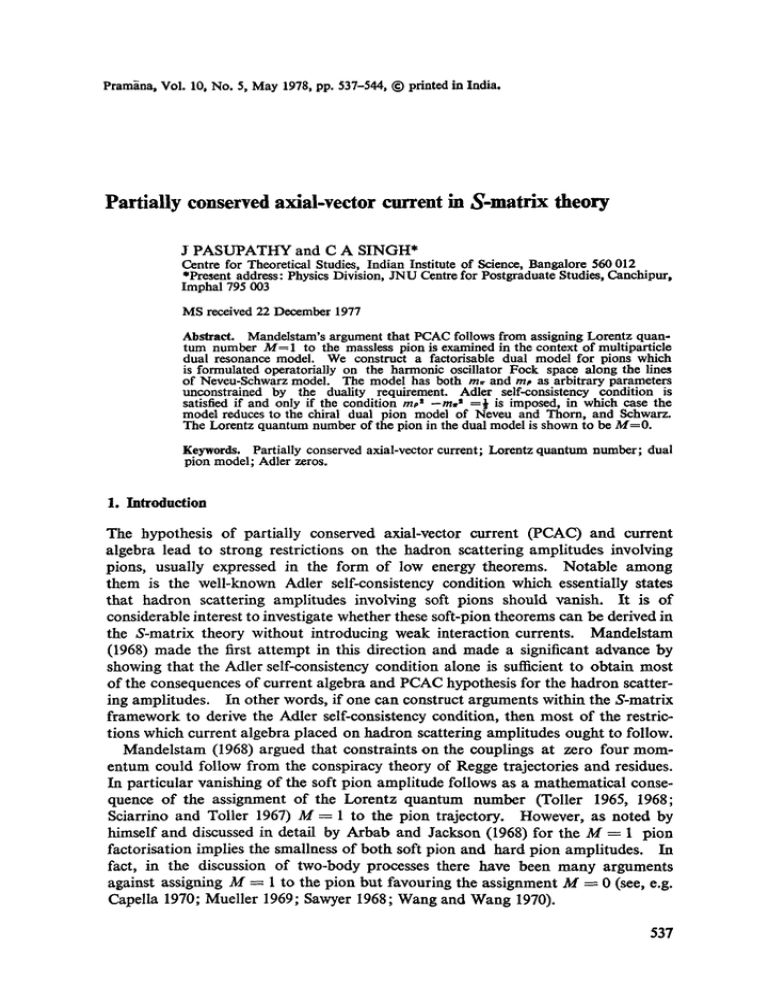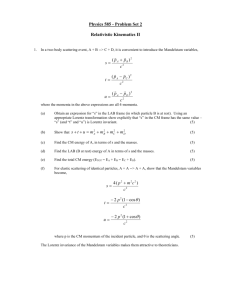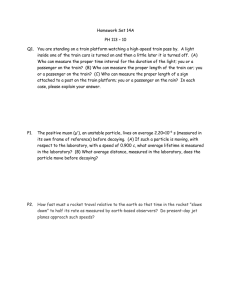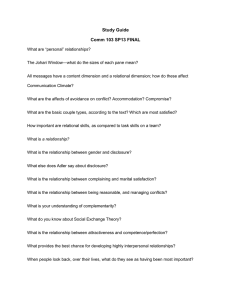Partially conserved axial-vector current in S-matrix theory
advertisement

Pram~na, Vol. 10, No. 5, May 1978, pp. 537-544, © printed in India.
Partially conserved axial-vector current in S-matrix theory
J P A S U P A T H Y and C A S I N G H *
Centre for Theoretical Studies, Indian Institute of Science, Bangalore 560 012
*Present address: Physics Division, JNU Centre for Postgraduate Studies, C,anehipur,
Imphal 795 003
MS received 22 December 1977
Mandelstam's argument that PCAC follows from assigning Lorentz quantum number M = I to the massless pion is examined in the context of multiparticle
dual resonance model. We construct a faetorisable dual model for pions which
is formulated operatorially on the harmonic oscillator Fock space along the lines
of Neveu-Schwarz model. The model has both m~ and mp as arbitrary parameters
unconstrained by the duality requirement. Adler self-consistency condition is
satisfied if and only if the condition rnpt --m, ~ =½ is imposed, in which case the
model reduces to the chiral dual pion model of Neveu and Thorn, and Schwarz,
The Lorentz quantum number of the pion in the dual model is shown to be M=0.
Abstract.
Keywords. Partially conserved axial-vector current; Lorentz quantum number; dual
pion model; Adler zeros.
1. Introduction
The hypothesis o f partially conserved axial-vector current (PCAC) and current
algebra lead to strong restrictions o n the hadron scattering amplitudes involving
pions, usually expressed in the form o f low energy theorems. Notable a m o n g
them is the well-known Adler self-consistency condition which essentially states
that hadron scattering amplitudes involving soft pions should vanish. It is o f
considerable interest to investigate whether these soft-pion theorems can be derived in
the S-matrix theory without introducing weak interaction currents. Mandelstam
(1968) made the first attempt in this direction and made a significant advance by
showing that the Adler self-consistency condition alone is sufficient to obtain most
o f the consequences o f current algebra and PCAC hypothesis for the h a d r o n scattering amplitudes. In other words, if one can construct arguments within the S-matrix
framework to derive the Adler self-consistency condition, then most o f the restrictions which current algebra placed on hadron scattering amplitudes ought to follow.
Mandelstam (1968) argued that constraints on the couplings at zero four m o m entum could follow from the conspiracy theory of Regge trajectories and residues.
In particular vanishing o f the soft pion amplitude follows as a mathematical consequence o f the assignment o f the Lorentz quantum n u m b e r (Toiler 1965, 1968;
Sciarrino and Toiler 1967) M = 1 to the pion trajectory. However, as noted by
himself and discussed in detail by Arbab and Jackson (1968) for the M = 1 pion
factorisation implies the smallness o f both soft pion and hard pion amplitudes. In
fact, in the discussion o f two-body processes there have been m a n y arguments
against assigning M -~ 1 to the pion but favouring the assignment M -~ 0 (see, e.g.
Capella 1970; Mueller 1969; Sawyer 1968; Wang and Wang 1970).
537
538
J Pasupathy and C A Singh
In the dual resonance model (DRM), the zrzr scattering amplitude of Lovelace
(1968) and Shapiro (1969) (LS amplitude) has Adler zeros when the leading p-trajectory is constrained to lie half a unit above the rr trajectory, that is by imposing
the condition*
a,--~n=½
or
mp2 - r e x 2 = 1 / 2 A
(1)
where a' g I(GeV) -2 is the universal slope of the Regge trajectories. This trajectory
splitting condition, eq. (1) occurs naturally as a requirement of duality in the operator
formulation of the chiral invariant dual multipion model of Neveu and Thorn (1971)
and Schwarz (1972). In this model the Adler condition is satisfied by a mechanism
originally discovered by Brower (1971); that is, when the four momentum of one of
the pions tends to zero, the N point function can be shown to contain a vanishing
beta-function (Neveu and Thorn 1971 ; Schwarz 1972).
In this paper we investigate whether there is a connection between PCAC and the
Lorentz quantum number of the pion in the dual resonance model. (We use the
term PCAC to mean existence of Adler zeros in the amplitude). The material of
this paper is organised as follows. In section 2 we construct a factorizable dual
pion model along the lines of Neveu and Schwarz (1971), Neveu and Thorn (1971)
and Halpern and Thorn (197I) which is formulated using boson and fermion oscillators. The model has masses of both p and rr arbitrary, but still satisfies the requirement of duality unlike the hitherto existing dual pion models. It is shown that Adler
self-consistency condition is satisfied if and only if the trajectory splitting condition
mp~ -- m~~ - : 1/2a' is imposed. In section 3 we consider the pion pole in the six
point function and using Mandelstam's (1968) argument and Arbab and Jackson's
(1968) result on the factorisation of Regge residue we show that the pion pole belongs
to the class with Lorentz quantum number M = 0 . In section 4 we state our conclusions.
2. PCAC in dual pion model and Lorentz quantum number of the pion
2.1. General remarks
The dual pion model of Neveu and Thorn (1971) and Schwarz (1972) (NTS model)
is known to possess Adler zeros and reduce (Schwarz and Wallace 1972) to the nonlinear ~-model in the zero-slope limit, that is in the limit A ~ 0. Let us consider the
six-point function in this model, Ae (Pl, P2, P3, P4, Ps, Ps) and look at the residue of the
pion-pole in a three pion channel, say at (plq-pz+pa)~=m/. We shall assume
m~=0. In the limit of the four-momentum Q=pl-kp~-kp3-->O, following Mandelstam's argument (which uses only the properties of the groups O (3, 1) and O (2, I))
the residue of the pion pole will vanish if the pion belongs to the class with Lorentz
quantum number M = 1. On the other hand by the property of factorisation, in
dual resonance model, the residue is a product of two four-pion amplitudes and will
*As pointed out by Brower (1971) the Adler condition may also be satisfied by imposing a
condition different from eq. (1). However there has been no operator for mulation of Brower's
model so far; so it lacks fundamentalsignificance.
PCAC in S-matrix theory
539
again vanish in the above limit ( Q ~ 0) if the amplitude possesses Adler zeros due to
condition like eq.(1). This situation tends to mask the difference, if any, between
the two hypotheses. Any possible difference between the two is however likely to
emerge more distinctly in a situation where one of them is made to hold only approximately. Since the PCAC hypothesis is of an approximate nature it Jis instructive
to investigate the Lorentz quantum number of the pion in a model in which there is
a small departure from the Adler self-consistency condition but the departure can be
made arbitrarily small. To this end we construct a dual pion model which has a
continuously variable parameter, in a certain limit of which, the model satisfies the
Adler self-consistency condition. In the model which we describe below such a
parameter turns out to be d a = (1/2~') 4- m, a -- mpL The Adler zeros appear only
in the limit d ~-~ 0.
2.2. Dual pion model with two mass variables
Fubini and Veneziano (1971) (FV) pointed out that in the conventional dual resonance model, the trajectory intercepts in different channels can be varied by introducing an extra space-like component, the so-called ' fifth component ', of the momenta
and a corresponding set of oscillators without destroying duality properties and still
preserving the full gauge group. Adopting the same procedure for the dual pion
model of Neveu and Schwarz (1971) (NS model) Halpern and Thorn (1971) (HT)
shifted the pion mass by an arbitrary amount (to make m~a >/0) from its value m~a=
--½ in the original NS model. However, to preserve duality p was still massless
as in the original NS model. Neveu and Thorn (1971) (NT) adopted this technique
of introducing extra components to the momenta and oscillators, to obtain another
variation of the original NS model. In their model all masses are shifted equally
from their values in the NS model. This also allows us to vary only one mass, say
m, a, and masses of all other particles are constrained in relation to this variable.
For example the mass of the p is still constrained by m~2 -- m~a = ½, a trajectory
splitting condition which endows Adler zeros to the model. The ~rrr-~rTr amplitude
in this model is the well-known Lovelace-Shapiro amplitude. Schwartz (1972) used
a slightly different operator formulation to obtain the same model as Neveu and
Thorn.
A useful distinction exists between the FV or HT way of introducing extra components and the NT way. The fifth component of FV and HT is introduced independent of the number of external particles N and hence the preservation of the factorisation property is obvious. In the NT way the number of extra dimensions depends
on N, yet the extra components of momenta are assigned in such a way that there is
only nearest neighbour coupling of the extra components, so that only one set of
oscillators contribute at any pole (Neveu and Thorn 1971). This mechanism of
nearest neighbour coupling preserves the factorisation property and is closely related
to the implementation of Adler's self consistency condition. The introduction of a
fifth component along the lines of HT results in shifting only the masses in the odd-G
channels, that too by an equal amount from their values in the original NS model,
whereas Neveu-Thorn's method of introducing extra components results in shifting
all masses equally.
It is easy to combine the NTS model and HT model to construct yet another modification of the NS model in which both m~a and m~a can be varied independently.
p.--6
540
J Pasupathy and C A Singh
Introducing the fifth component of momenta as in the Halpern-Thorn (1971) model
as well as the N extra space-like components as in the Neveu-Thorn (1971) model we
write
k~ - - (k. --d, ~/v'~, --~/x/~, O, 0 .... O, O)
k"~ ~ (k 2, q-d, O, clx/~2, --clv'~2, 0 .... O, O)
k,
= (k,, (--1)' d, 0 . . . . ely'S, - - c l V ~ , 0 .... O, O)
k N - 1 : - (kN-1, --d, O, 0 ... O, c/v'~2, --c/v'2)
kAN = (kN, +d, --c/x~2, 0 .... O, c/V'~2)
(2)
where k I, k 2, . . . , k N are the four-momenta of the particles 1, 2, 3. . . . . N respectively. The model can now be easily written down by replacing the momenta and
oscillators in the original Neveu-Schwarz model by the above (N:5)-dimensional
momenta and the corresponding (N %-5)-dimensional set of operators. We briefly
describe below the construction of the N-point function. The (N+5)-analogues
of the usual harmonic oscillator operators satisfy the algebra
[^t~an' am^V]= _ n g ~ V S. ' -,.
(3)
{ b^t~
m, ~:1
(4)
m,
:
--glOVe,.,_.
= 0
(5)
where the indices/~ and v run over the (iV÷ 5) components. In addition we also
have the momentum operator a~ = ~¢/2.p~' and its canonical conjugate (position)
operator ~v satisfying
[a~, ~¢v] _~_ __.v'~ig.v.
(6)
In analogy with the standard procedure (Neveu and Schwarz 1971; Schwarz 1973)
the vertex operator is given by
=
# ,o(k3
(7)
where
^
x cxp ( - ¢ ~ . k
• ~:oo.=~
a.l.)
(8)
in S - m a t r i x theory
541
~rt~ = ~"~
b~ n:=[=~-, d=~, ""
/_.,n~--oo ?f
(9)
PCAC
and
In addition we define
Lo = - - ] l a ° " % - -
nffil - - a . .
a.--
(I0)
n=½ n b _ n ' b u.
In terms of these operators, the N-point function (in the original Fl-space formulation of NS model (Neveu and Schwarz 1971)) is given by
A
AN :
^
^
^
^
^
^
/~
~0, - - k l [ k 1 • bl/2 V(k~) (Lo--l) -1 V ( k a ) . . . .
^
^
^
^
A
^
. . . . (L0--1) -1 V(kN) k N " b_H2 [0, kN).
(11)
The extra components of momenta are constrained by the requirement of conformal
^
symmetry k~2 = --½, that is
m~ ~ - - c 2 - - d z = -- ~.
(12)
The trajectory functions in the even and odd G-parity channels are
for even-G channels
~p (s) = 1 q- ( s - - c ~)
(13a)
and
~ (s) = ½ q- ( s - - c ~ - - d 2)
for odd-G channels
(13b)
from which it follows that
mp2 ~_~ ¢2; rap2 _ m 2 = ½ __ d 2.
(14)
The amplitude given by eq. (11) has the properties of duality, factorisations and incorporates the tachyon killing mechanism of the Neveu-Schwarz model. The latter
is apparent when we rewrite eq. (11) in the F¢-formulation (Neveu et al 1971) a s
^
^
^
^
/,,
/~
^
A N == (O,--k^ll V(k3)(L0--1~)-I V ( k 3) .... ( L o - - ~ ) -1 V (~¢N_.I) [ 0, kN>. (15)
Using the standard technique of writing the propagator as
( ^L ° - ½)-1 =
ol d x x
-w
we have the following integral representation of the N-point function
A N = jfl 0tiN--2
i=2 dxi x i - P * * - i
^
~
^
^
× (ol k2. I(1)ks'H(xs)
^
×
^
II
(l--xiXi+l...Xf1-2~* "~J
2<i<]<N--I
^
^
H(x x.x4...
..)l 0) 06)
J Pasupathy and C A Singh
542
where
P, : (kz--}-k~,+...+k,); n ( z ) = ,V,nbn z -~
Adler zeros: If we now set d : 0 the above model reduces to the NTS model,
which is known to possess Adler zeros. In d -=: 0 case it can be easily shown (Neveu
and T h o r n 1971) from eq. (16) that for example when k 2 ~ 0
A N -->.[ f ~ dx2 X; l+c' (l__xt) -1-c2]
The first factor in eq. (17) is
fl0 dx~ x ; l+c" (l--x,) - 1 - c ' = B(c',--c ~) = O.
(18)
This is the Brower mechanism (Brower 1971) for implementing the Adler self-consistency condition. This depends crucially on the fact that when d = 0 in eq. (16) the
^
/N
p r o d u c t k ~ k j = k c k j except for the nearest neighbours, so that as the four vector
k~ ~ O, k~'ks-~ 0 for j ~ 1,3. For d # 0 the latter circumstance does not hold so that
the amplitude given by eq. (16) does not reduce to the form given by eq. (17) when
ks-~ 0. Therefore the factorisable dual model constructed by us [eq. (11) or eq. (15)
or eq. (16)] does not possess Adler zeros in general unless d ~ 0.
3. The pion pole and its Lorentz quantum number
Let us now look at the pion pole in the six-point function o f the present model.
Following standard procedure we obtain from eq. (11) the six-point function with
external momenta ordered cyclically,
•
- . p (s~2)
U 12
- ~ . (su)- 1
U24
0
-~,(s18)-1
u13
-
U34"
(s,,)
dul, dui3 du ,
(1~U12 U13) (I--ula
-ap(sl0
U14
(s3J--1
u35°~
-=p (s~8)
U23
U14)
-
u25aa
(s=~)
^
Z (k, u)
(19)
where st~ : (k~ + k~+t + ... + kj) ~ and u t / s are the usual Chan variables, and
t%
Z (k, u) is given by
A
Z ( k , U) :
A
A /N F, /k
,~
( [ ( k 1 " k 2 k 3 " k 4 k 5 " k 6) (U12 /434 /ALl) -1 ~-
+ [ (k~' k 2 k 3 • k e k 4 • k 5) u u (ut2 u4~) -1 + P c (2)1
Pc (1)]
PCAC in S-matrix theory
A
-- [ (kx"
A
A
A
A
543
A
--1
k2 ks' k5 k4" Ice)uu u12 + P, (5)1
A
A
A
A
A
q- [ (k t • k 4 k~" k. k s • k s ula Uu "1" P~ (2)1
- - (k t • k, k," k s k a • k, ula u ~ uas) }
(20)
where the symbol PC(n) means one must add the n independent terms obtained by
cyclic permutation of the preceding expression. Computing the residue of Ae
(kx,k2,ks,k4,ks,ke) at the pion pole corresponding to a.(sla):-0 we get the pion pole
residue in the factorised form
[(2k~. Q+2d ~) B ( I - - ~ , 1--~)] [(--2k6- Q+2d ~) B (l--a1,, 1--a~)]
= A~ (k 1, kz, ka, - - Q) A 4 (Q, k4, ks, k6)
(21)
where Q = k t + k ~ ÷ k 3 and B(x, y) is the Euler beta-function and A4 is the four-point
function,
A,(ki, tq, k3, - Q ) = ( 2 k 2 . fl +2d *) S (1--a12, 1 - - ~ )
= (1--al~--a23) B (1--axz, 1 --am)
(22)
which is the canonical Lovelace-Shapiro four-point function. It is evident from
eq. (22) that our dual model has Adler zeros if and only if dZ=0.
The M quantum number: Returning to the six point function given by eq. (19) one
can perform an O(3,1) analysis (Toiler 1965, 1968) corresponding to Qv=(kx+ka+ks)
= --(k4+ks+ks)v ~ 0 to find the M quantum number of pion. However without
going through the mathematics we can show that pion belongs to M = 0 representation as follows. We can vary the parameters c and d without destroying duality
and factorisation so that we can choose
d#0
but m. ~ = - ½ + c
z+d ~=0.
We have seen that when d ~ 0 our model does not possess an Adler zero and must
belong to M = 0 representation as otherwise there will be a contradiction with Mandelstam's argument that if [ M I >71, Adler zeros are present. Although by continuity,
we expect that as we vary the parameter d in our model the pion will continue to
have M = 0 , it remains to be checked that the M value does not abruptly change, for
example to M = 1 as d becomes zero. This latter fact can be established, using the
results of Arbab and Jackson 0968) who showed that if pion has M = l , then by
factorization even the hard pion amplitudes should vanish linearly as x / p , Qv
being the pion four momentum. Returning to eq. (21) and setting d = 0 , we see that
the pion residue does not vanish even if Q~=0 unless the four momentum Qlt also
vanishes.
P.--7
544
J Pasupathy and C A Singh
4. Discussion
We are thus led to conclude that for all values of d 8 in our model, the pion has the
Lorentz quantum number M : 0 .
The Adler self consistency conditon is satisfied
if and only if the trajectory splitting condition eq. (1) is satisfied. Our model does
not suffer from the defect of requiring that hard pion amplitudes also vanish if
Q 2 : 0 (but Q~#0), which would be the case if pion had M = I .
Since our model
satisfies the requirement of duality and factorisation for all values of m, ~ and m, 2,
many other interesting questions like the spectrum of physical states, the field theory
corresponding to the zero slope limit of the model, should be investigated.
References
A r b a b F a n d Jackson J D 1968 Phys. Rev. 176 1796
Brower R C 1971 Phys. Lett. B34 143
Capella A 1970 Nucl. Phys. 1322 225
Fubini S and Veneziano G 1971 Ann. Phys. 63 12
H a l p e r n M B and T h o r n C B 1971 Phys. Lett. B35 441
Lovelace C 1968 Phys. Lett. B28 264
Mandelstam S 1968 Phys. Rev. 168 1884
Mueller A H 1969 Phys. Rev. 172 1516
Neveu A and Schwarz J H 1971 NucL Phys. 1331 86
Neveu A a n d T h o r n C B 1971 Phys. Rev. Lett. 27 1758
Neveu A, Schwarz J H and Thorn C B 1971 Phys. Lett. B35 529
Sawyer R F 1968 Phys. Rev. Lett. 21 764
Schwarz J H 1972 Phys. Rev. D5 886
Schwarz J H a n d Wallace D J 1972 Phys. Rev. D6 723
Schwarz J H 1973 Phys. Rep. C8 270
Sciarrino A and Toller M 1967 J. Math. Phys. 8 1252
Shapiro J 1969 Phys. Rev. 179 1345
Toiler M 1965 Univ. of Rome Rep. No. 76
Toller M 1968 Nuovo Cimento A53 671
W a n g J M a n d Wang L L 1970 Phys. Rev. D1 663


